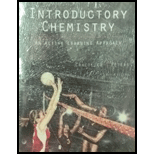
Concept explainers
Interpretation:
Classification of
Concept introduction:
The structural formula is a simplified model that represents the arrangement of atoms and bonds in a molecule. Amines are derivative of ammonia obtained by substitution of hydrogen atom attached to the nitrogen atom by an alkyl group. Based on the alkyl groups, amines are classified as:
1. Primary amines: The nitrogen atom is attached to a alkyl group and 2 hydrogen atoms.
2. Secondary amines: The nitrogen atom is attached to a two alkyl groups and a hydrogen atom.
3. Tertiary amines: The nitrogen atom is attached to three alkyl groups and zero hydrogen atom.
The general name for amines is as follows,
Name of alkyl group + amine
Want to see the full answer?
Check out a sample textbook solution
Chapter 21 Solutions
Bundle: Introductory Chemistry: An Active Learning Approach, 6th + LMS Integrated for OWLv2, 4 terms (24 months) Printed Access Card
- Draw a Lewis structure for an isomer of C2H5NO that is an amide, and draw a second Lewis structure for a second isomer of C2H5NO that has both an amine functional group and an aldehyde functional group.arrow_forwardThe clear formula of an active drug substance is given below. Write the closed formula of this compound, it consists of the combination of two organic compounds that we have seen so far. Write the name of these two structures.arrow_forwardAspartame, an artificial sweetener used in Equal® and diet beverages, has the following structure. Identify the functional groups in Aspartame. II NH, O OH O 1= ester; I| = amide; III = amine O 1 = ester; I| = amine; III = amide O1= ether; I| = amide; III = amine O 1 = ether; I| = amine; III = amide O 1 = anhydride; Il = ketone; I|| = aminearrow_forward
- Which structural formula does CF3CF3 belongs to. alkyl halide, alcohol, amine, carboxylic acid, ester, or amide.arrow_forwardCreate two separate structures for the compound C5H9NO that are not amines.arrow_forward1. Use the image provided to answer the question in detail: a) Two of the earliest drug molecules featured in Chapter 8 are Vicodin and Heroin, whose chemical structures are very similar. Both of these molecules contain an amine functional group and several rings. Indicate the number of aromatic rings in each structure, and identify the amine functional group in each molecule as primary, secondary, or tertiary.arrow_forward
- Select the functional groups that are PRESENTS in the compund. Choose between these options below. -Ketone, Aromatic, Amine, Carboxylic Acid, Amide, Aldehyde, Ether, Ester.arrow_forward3. Differentiate the physical and chemical properties of the various organic compounds.arrow_forwardIn terms of structure, how are geometric isomers different from structural isomers?arrow_forward
 Introductory Chemistry: An Active Learning Approa...ChemistryISBN:9781305079250Author:Mark S. Cracolice, Ed PetersPublisher:Cengage Learning
Introductory Chemistry: An Active Learning Approa...ChemistryISBN:9781305079250Author:Mark S. Cracolice, Ed PetersPublisher:Cengage Learning Chemistry: The Molecular ScienceChemistryISBN:9781285199047Author:John W. Moore, Conrad L. StanitskiPublisher:Cengage LearningChemistry: Matter and ChangeChemistryISBN:9780078746376Author:Dinah Zike, Laurel Dingrando, Nicholas Hainen, Cheryl WistromPublisher:Glencoe/McGraw-Hill School Pub Co
Chemistry: The Molecular ScienceChemistryISBN:9781285199047Author:John W. Moore, Conrad L. StanitskiPublisher:Cengage LearningChemistry: Matter and ChangeChemistryISBN:9780078746376Author:Dinah Zike, Laurel Dingrando, Nicholas Hainen, Cheryl WistromPublisher:Glencoe/McGraw-Hill School Pub Co Organic Chemistry: A Guided InquiryChemistryISBN:9780618974122Author:Andrei StraumanisPublisher:Cengage Learning
Organic Chemistry: A Guided InquiryChemistryISBN:9780618974122Author:Andrei StraumanisPublisher:Cengage Learning Living By Chemistry: First Edition TextbookChemistryISBN:9781559539418Author:Angelica StacyPublisher:MAC HIGHER
Living By Chemistry: First Edition TextbookChemistryISBN:9781559539418Author:Angelica StacyPublisher:MAC HIGHER Chemistry: An Atoms First ApproachChemistryISBN:9781305079243Author:Steven S. Zumdahl, Susan A. ZumdahlPublisher:Cengage Learning
Chemistry: An Atoms First ApproachChemistryISBN:9781305079243Author:Steven S. Zumdahl, Susan A. ZumdahlPublisher:Cengage Learning





